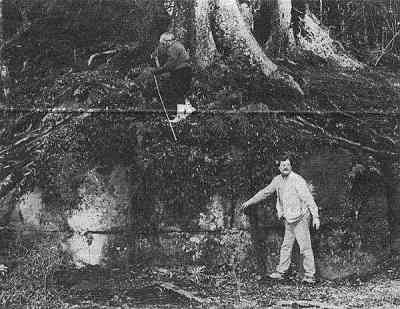 |
Science Frontiers ONLINE No. 107: Sep-Oct 1996 |
|
|
Who Built The Kaimanawa Wall?
Some 30 kilometers south of Lake Taupo, in New Zealand, stands an enigmatic array of stone blocks. It "looks" like a wall; a human-built wall. It also "looks" old; perhaps 2,000 years old according to some. Who built it? Passions are running high in New Zealand, where three hypotheses are being advanced:
- The wall was built some 2,000 years ago by the first settlers of New Zealand, the Waitahas, who were subsequently nearly exterminated by the Maoris, who arrived only 800 years ago. There are political problems with this theory, for the Maoris insist they are the original New Zealanders and therefore are due compensation for lands expropriated by later Europeans.
- The wall is merely what's left of a sawmill built only 50 or so years ago.
- The wall is simply a natural rock formation that has happened to split neatly into rectangular blocks -- like those slabs of beach rock that comprise the controversial Bimini "road" in the Bahamas.
Future study of the "wall" will doubtless narrow the list to one. Meanwhile, let's take a look at the wall itself.
B. Brailsford, of Christchurch, has been the chief investigator of the Kaimanawa wall, aided by American D.H. Childress, and others. The stones that make up the wall are 4-ton blocks of ignimbrite, a soft volcanic rock that could have been easily dressed with stone tools. The wall is topped by a red beech tree 2.9 meters in circumference and over a meter of accumulated humus. According to Brailsford, who was interviewed by the Listener:
"There was no doubt that the stones had been cut. The four visible stones in the front wall were a uniform 1.6 metres tall, and 1 metre wide. In one place he could insert his arm into a root-ridden cavity and feel the back face -- and the front face of the next tier. The faces were uncannily smooth, with no saw or adze marks. The interstices where the blocks join were knife-blade thin.
"Further up the hill, the tops of other stones protruded, suggesting a more extensive structure was buried in the hill."
Supporting the contention that a pre-Maori people lived in New Zealand are the bones of the kiore, a type of rat alien to New Zealand, which was likely introduced by the first settlers. Some kiore bones have been dated as 2,000 years old -- centuries before the first Maoris arrived.
Needless to say, New Zealand archeologists and anthropologists are not anxious to drastically revise their fundamental paradigm assigning the discovery and colonization of New Zealand to the Maoris. But Brailsford and Childress are even more iconoclastic: They suggest links to a pre-Polynesian culture; a culture that left similar megalithic structures elsewhere in the Pacific and along the west coast of South America.
(Chapple, Geoff; "Megalith Mystery," Listener, p. 28, May 4, 1996. Anonymous; "Kaimanawa Wall a Natural Volcanic Rock Formation," New Zealand Herald, May 4, 1996. Wellwood, Elinore; "Experts Argue over Wall's Origins," Waikato Times, May 8, 1996. Cr. T. Brown.)
Comment. See SF#97 for an apparently natural wall at Chatata, Tennessee, that stirred up a similar controversy over a century ago.
Reference. Many other mysterious walls are covered in our Handbook: Ancient Man. To order, visit here.
 | Investigating New Zealand's Kaimanawa wall. The stone blocks do seem to be too regular to be a natural formation. B. Brailsford (above), D. H. Childress (below). (Cr. T. Brown) |